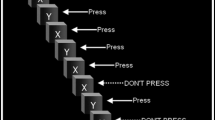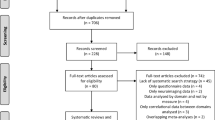Abstract
Rationale
Research on the relative impact of trait impulsivity vs. drug exposure on neuropsychological probes of response inhibition vs. response perseveration has been posited as a valid pathway to explore the transition between impulsivity and compulsivity on psychostimulant dependence.
Objectives
The objectives of this study are to examine performance differences between cocaine-dependent individuals (CDI) and healthy comparison individuals (HCI) on neuropsychological probes of inhibition and perseveration and to examine the predictive impact of trait impulsivity—a proxy of premorbid vulnerability, and severity of cocaine use—a proxy of drug exposure, on CDI’s performance.
Methods
Forty-two CDI and 65 HCI were assessed using the UPPS-P Scale (trait impulsivity), the Stroop and go/no-go (inhibition) and revised-strategy application and probabilistic reversal tests (perseveration).
Results
CDI, compared to HCI, have elevated scores on trait impulsivity and perform significantly poorer on inhibition and perseveration, with specific detrimental effects of duration of cocaine use on perseveration.
Conclusions
CDI have both inhibition and perseveration deficits; both patterns were broadly indicative of orbitofrontal dysfunction in the context of reinforcement learning. Impulsive personality and cocaine exposure jointly contribute to deficits in response perseveration or compulsivity.



Similar content being viewed by others
References
Adams KM, Brown GG, Grant I (1985) Analysis of covariance as a remedy for demographic mismatch of research subject groups: some sobering simulations. J Clin Exp Neuropsychol 7:445–462
Belin D, Mar AC, Dalley JW, Robbins TW, Everitt BJ (2008) High impulsivity predicts the switch to compulsive cocaine-taking. Science 320:1352–1355
Brewer JA, Worhunsky PD, Carroll KM, Rounsaville BJ, Potenza MN (2008) Pretreatment brain activation during Stroop Task is associated with outcomes in cocaine-dependent patients. Biol Psychiatry 64:998–1004
Colzato LS, van den Wildenberg WPM, Hommel B (2007) Impaired inhibitory control in recreational cocaine users. PLoS One 2:1143
Dalley JW, Fryer TD, Brichard L, Robinson ES, Theobald DE, Lääne K, Peña Y, Murphy E, Shah Y, Probst K, Abakumova I, Aigbirhio FI, Richards HK, Hong Y, Baron JC, Everitt BJ, Robbins TW (2007) Nucleus accumbens D2/3 receptors predict trait impulsivity and cocaine reinforcement. Science 315:1267–1270
Dalley JW, Everitt BJ, Robbins TW (2011) Impulsivity, compulsivity and top–down cognitive control. Neuron 69:680–694
Delis DC, Kaplan E, Kramer JH (2001) Delis–Kaplan executive function system. Psychological Corporation, San Antonio
Ersche KD, Roiser JP, Robbins TW, Sahakian J (2008) Chronic cocaine but not chronic amphetamine use is associated with perseverative responding in humans. Psychopharmacology 197:421–431
Fernández-Serrano MJ, Pérez-García M, Schmidt Río-Valle J, Verdejo-García A (2010) Neuropsychological consequences of alcohol and drug abuse on different components of executive functions. J Psychopharmacol 24:1317–1332
Fernández-Serrano MJ, Pérez-García M, Verdejo-García A (2011) What are the specific vs. generalized effects of drugs of abuse on neuropsychological performance? Neurosci Biobehav Rev 35:377–406
Field A (2005) Discovering statistics using SPSS, 2nd edn. Sage, Thousand Oaks
Fineberg NA, Potenza MN, Chamberlain SR, Berlin HA, Menzies L, Bechara A, Sahakian BJ, Robbins TW, Bullmore ET, Hollander E (2010) Probing compulsive and impulsive behaviors, from animal models to endophenotypes: a narrative review. Neuropsychopharmacology 35:591–604
Guillot CR, Fanning JR, Bullock JS, McCloskey MS, Berman ME (2010) Effects of alcohol on tests of executive functioning in men and women: a dose response examination. Exp Clin Psychopharmacol 18:409–417
Kaufman JN, Ross TJ, Stein EA, Garavan H (2003) Cingulate hypoactivity in cocaine users during a go–no go task as revealed by event-related functional magnetic resonance imaging. J Neurosci 23:7839–7843
Koob GF, Volkow ND (2010) Neurocircuitry of addiction. Neuropsychopharmacology 35:217–238
Lawrence AJ, Luty J, Bogdan NA, Sahakian BJ, Clark L (2009) Impulsivity and response inhibition in alcohol dependence and problem gambling. Psychopharmacology 207:163–172
Leland DS, Arce E, Feinstein JS, Paulus MP (2006) Young adult stimulant users’ increased striatal activation during uncertainty is related to impulsivity. Neuroimage 33:725–731
Levine B, Dawson D, Boutet I, Schwartz ML, Stuss DT (2000) Assessment of strategic self-regulation in traumatic brain injury: Its relationship to injury severity and psychosocial outcome. Neuropsychology 14:491–500
Li CR, Huang C, Yan P, Bhagwagar Z, Milivojevic V, Sinha R (2008) Neural correlates of impulse control during stop signal inhibition in cocaine-dependent men. Neuropsychopharmacology 33:1798–1806
Marczinski CA, Abroms BD, van Selst M, Fillmore MT (2005) Alcohol-induced impairment of behavioral control: differential effects on engaging vs. disengaging responses. Psychopharmacology 182:452–459
Quednow BB, Kuhn KU, Hoppe C, Westheide J, Maier W, Daum I, Wagner M (2007) Elevated impulsivity and impaired decision-making cognition in heavy users of MDMA (“Ecstasy”). Psychopharmacology 189:517–530
Smith GT, Fischer S, Cyders MA, Annus AM, Spillane NS (2007) On the validity and utility of discriminating among impulsivity-like traits. Assessment 14:155–170
Streeter CC, Terhune DB, Whitfield TH, Gruber S, Sarid-Segal O, Silveri MM, Tzilos G, Afshar M, Rouse ED, Tian H, Renshaw PF, Ciraulo D, Yurgelun-Todd DA (2008) Performance on the Stroop predicts treatment compliance in cocaine-dependent individuals. Neuropsychopharmacology 3:827–836
Swainson R, Rogers RD, Sahakian BJ, Summers BA, Polkey CE, Robbins TW (2000) Probabilistic learning and reversal deficits in patients with Parkinson’s disease or frontal or temporal lobe lesions: possible adverse effects of dopaminergic medication. Neuropsychologia 38:596–612
Tapert SF, Schweinsburg AD, Drummond SP, Paulus MP, Brown SA, Yang TT, Frank LR (2007) Functional MRI of inhibitory processing in abstinent adolescent marijuana users. Psychopharmacology 194:173–183
Tsuchida A, Doll BB, Fellows LK (2010) Beyond reversal: a critical role for human orbitofrontal cortex in flexible learning from probabilistic feedback. J Neurosci 30:16868–16875
Verdejo-García A, Pérez-García M (2007) Profile of executive deficits in cocaine and heroin polysubstance users: common and differential effects on separate executive components. Psychopharmacology 190:517–530
Verdejo-García A, López-Torrecillas F, Aguilar de Arcos F, Pérez-García M (2005) Differential effects of MDMA, cocaine, and cannabis use severity on distinctive components of the executive functions in polysubstance users: a multiple regression analysis. Addict Behav 30:89–101
Verdejo-García A, Perales JC, Pérez-García M (2007a) Cognitive impulsivity in cocaine and heroin polysubstance abusers. Addict Behav 32:950–966
Verdejo-García A, Rivas-Pérez C, Vilar-López R, Pérez García M (2007b) Strategic self-regulation, decision-making and emotion processing in polysubstance abusers in their first year of abstinence. Drug Alcohol Depend 86:139–146
Verdejo-García A, Lawrence AJ, Clark L (2008) Impulsivity as a vulnerability marker for substance-use disorders: Review of findings from high-risk research, problem gamblers and genetic association studies. Neurosci Biobehav Rev 32:777–810
Verdejo-García A, Sánchez-Fernández MM, Alonso-Maroto LM, Fernández-Calderón F, Perales JC, Lozano O, Pérez-García M (2010) Impulsivity and executive functions in polysubstance-using rave attenders. Psychopharmacology 210:377–392
Whiteside SP, Lynam DR (2001) The five factor model and impulsivity: using a structural model of personality to understand impulsivity. Personal Individ Differ 30:669–689
Woicik PA, Urban C, Alia-Klein N, Henry A, Maloney T, Telang F, Wang GJ, Volkow ND, Goldstein RZ (2011) A pattern of perseveration in cocaine addiction may reveal neurocognitive processes implicit in the Wisconsin Card Sorting Test. Neuropsychologia 49:1660–1669
Zald DH, Andreotti C (2010) Neuropsychological assessment of the orbital and ventromedial prefrontal cortex. Neuropsychologia 48:3377–3391
Acknowledgement
This work was funded by the Spanish Ministry of Education under the FPU national plan (grant reference AP 2005-1411), the Spanish Ministry of Science and Innovation (MICINN, Dirección General de Investigación y Gestión del Plan Nacional I+D+i) under grant PSI2009-13133 and grant SEJ 2006-8278 by the Junta de Andalucía through the grant P07.HUM 03089 and by the Plan Nacional sobre Drogas (2009), COPERNICO grant.
Conflict of interest
The authors have no conflicts of interest to declare.
Author information
Authors and Affiliations
Corresponding authors
Electronic supplementary materials
Below is the link to the electronic supplementary material.
Rights and permissions
About this article
Cite this article
Fernández-Serrano, M.J., Perales, J.C., Moreno-López, L. et al. Neuropsychological profiling of impulsivity and compulsivity in cocaine dependent individuals. Psychopharmacology 219, 673–683 (2012). https://doi.org/10.1007/s00213-011-2485-z
Received:
Accepted:
Published:
Issue Date:
DOI: https://doi.org/10.1007/s00213-011-2485-z




